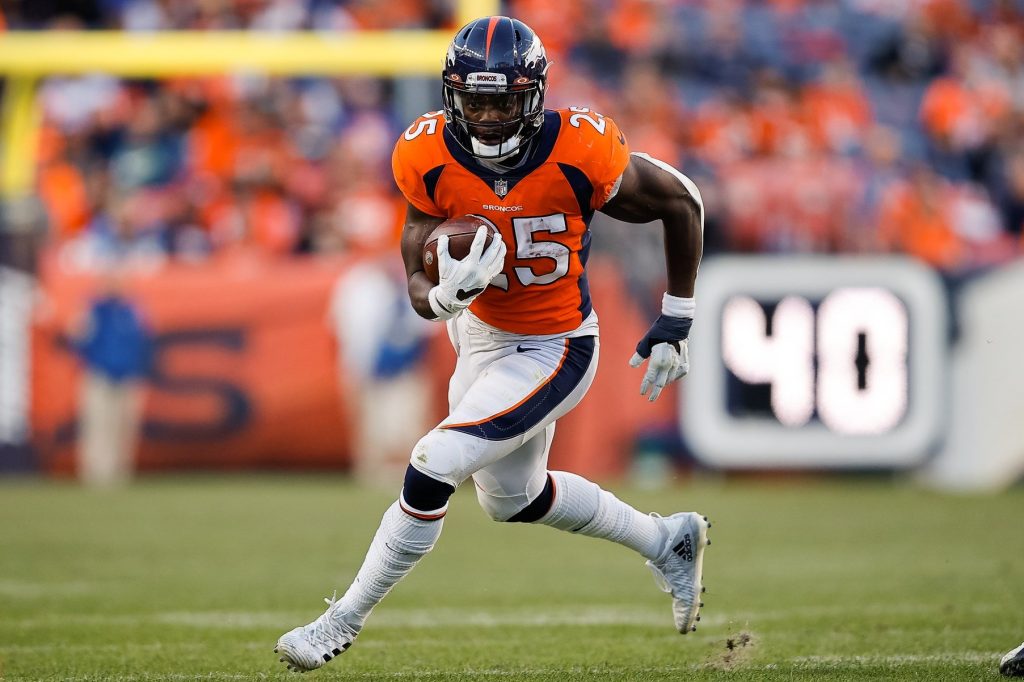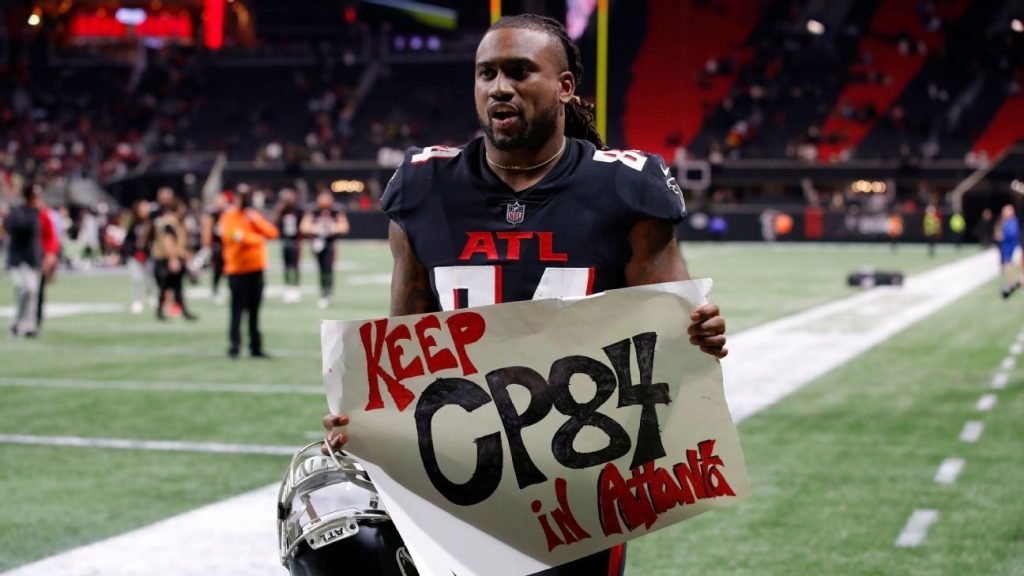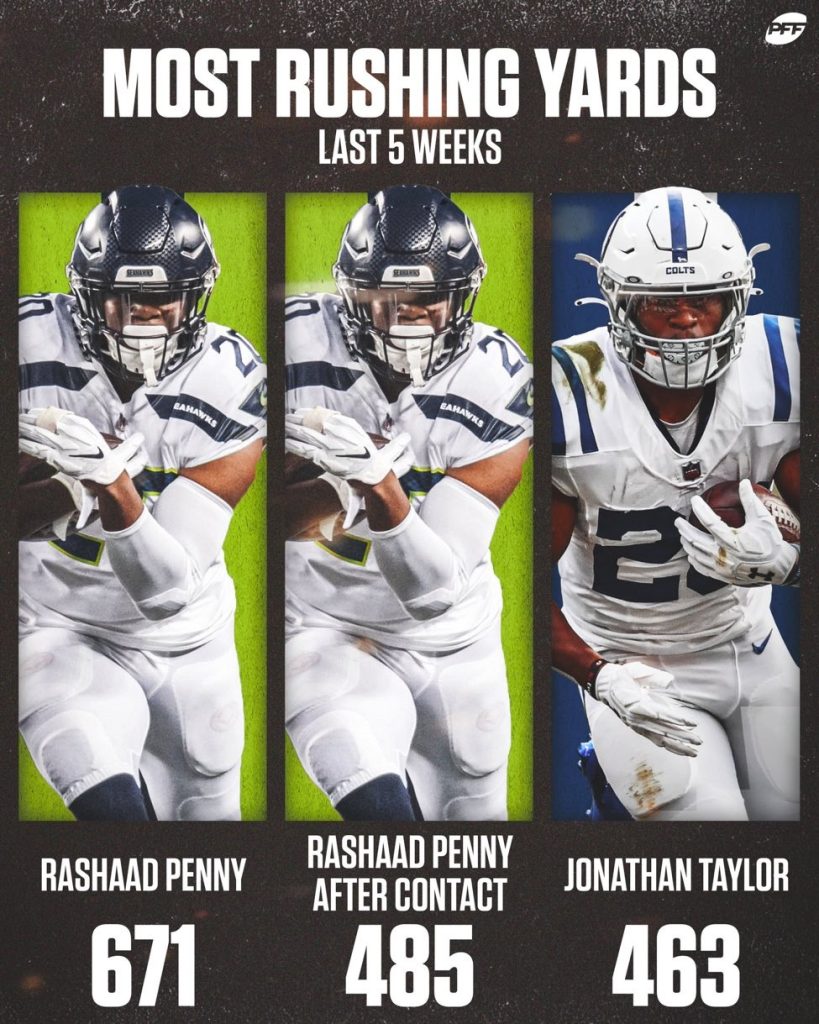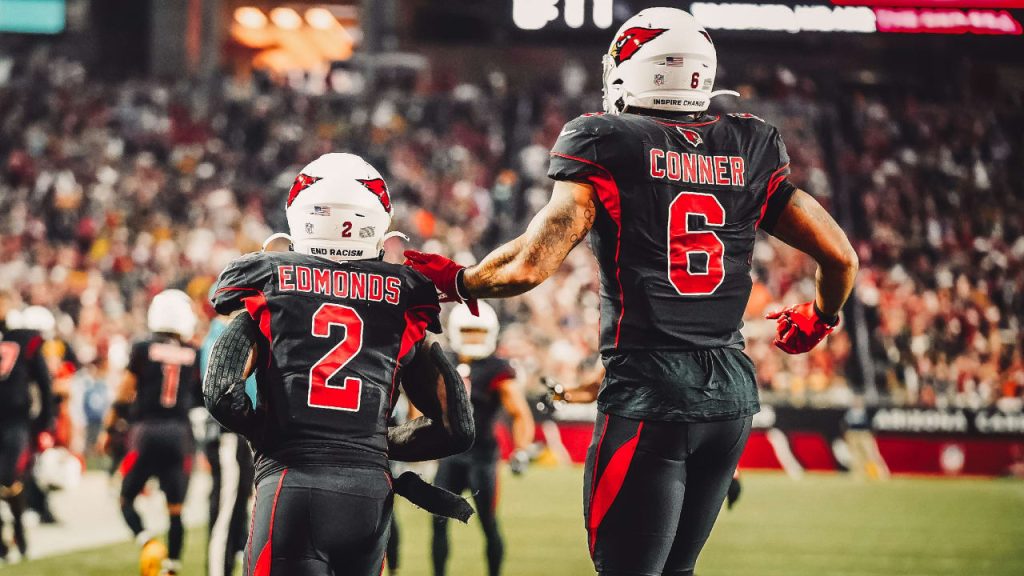Generally, the running back free agent hot stove results in a slow simmer rather than a piping hot boil. NFL teams tend to lock up good, young running backs at the conclusion of their rookie contracts while the market is littered with nothing more than has-beens.
We often see running backs face a sharp decline shortly after they reach the summit of their careers. The running back position is easily replaceable. Free agency, however, can change the course of a player’s career, and thus, your fantasy team.
Some guys on this list recently changed teams and were left for dead by the fantasy football industry. Still, nobody thought twice about James Conner leaving Pittsburgh when his 14 rushing touchdowns for Arizona carried you to the fantasy football playoffs. Aaron Jones managers already forgot about their fears of him leaving Green Bay last offseason. Although this group doesn’t feature any fantasy superstars like Jones, there are plenty of players who could see their value dramatically shift upon inking a new deal.
So, which free-agent running backs should you be investing in? Which ones will change teams, and which will stay put? Perhaps most importantly, what will the ripple effect be of their new contracts? Let’s find some answers, beginning with the bigger names.
Leonard Fournette
You’d be forgiven if you thought Leonard Fournette was older; however, he just turned 27. It feels like he’s been around longer than the 2017 NFL draft when he was selected fourth overall. Fournette will be entering just his sixth year in the NFL next season with 3,810 career (regular season) rushing yards to his name.
Fournette was not short on doubters in September and October when he was being drafted as RB38. He did, however, prove the doubters wrong as he rushed 180 times for 812 yards and eight touchdowns this season while tallying 454 receiving yards and another two touchdowns through the air. After playing in 14 games, his regular-season ended early after suffering a hamstring strain, but he finished the season as RB4 in PPR points-per-game with 18.3. A big reason for regular season Lenny’s success this year is his receiving work, which surprised many in the fantasy football world.
A quick look at his career numbers tells you that Fournette is a quality receiver out of the backfield. His 454 receiving yards this season are his second-highest after posting 522 in 2019. His pass-catching chops will certainly serve him well on the free-agent market as so many early-down backs are a liability on third down, and many third-down backs aren’t productive enough between the tackles for early downs. This is part of what makes fantasy football Lenny an appealing option.
Fournette received a $17.8 million signing bonus when he was drafted. Still, in total, his five annual salaries sit at just over $8 million, so the odds are that he will look to secure the bag this go-round. His projected market value is just over $6 million, with Spotrac projecting him for a two-year, $12.2 million deal. With the recent news that Tom Brady is likely to retire, Tampa Bay becomes a much less appealing option if they don’t back up the brinks truck for him.
Fournette has proven himself enough that free agent Lenny’s decision won’t crater his fantasy value if he decides to cash bigger checks elsewhere. However, signing on with a lesser offense would likely ding his production somewhat. Alongside TB12 with the Bucs, Lenny is a borderline RB1/2. If he takes his talents to South Beach, where the fish need a lead back, or somewhere else in free agency, he’s best viewed as more of a low-end RB2.
Prediction: Leonard Fournette signs a multi-year deal with the Miami Dolphins.
Melvin Gordon
Once considered a fantasy football superstar, Gordon will hit free agency again after his two-year stint in the Mile High city. In a league devoid of every-down running backs capable of running between the tackles, catching passes, and pass blocking, Gordon still fits the bill as he gets ready to turn 29.
After a solid but unspectacular rookie season, Gordon became one of the premier players at the position when he posted PPR finishes of RB7, RB5, and RB8 in his next three seasons. During that stretch, the first-round pick out of Wisconsin tallied 2,987 rushing yards and 28 rushing touchdowns. Equally impressive, he added 1,385 receiving yards and 10 more touchdowns through the air.
Upon peeling back the curtain, however, the reality is that Gordon was mostly inefficient before losing his job to Austin Ekeler. Only Le’Veon Bell handled more rushing attempts in 2016 and 2017 combined when Gordon averaged just 3.9 yards-per-carry. His value largely hinged on touchdowns and receiving work.
You can question Gordon’s lack of efficiency but, the bigger question mark surrounding him is how much he has left in the tank. He is fast approaching the 1,500-carry mark, which is a notorious number for the decline in running back. Even so, Gordon showed he can still be effective when splitting the backfield work. Despite the arrival and emergence of Javonte Williams, MGIII toted the rock 203 times for 918 yards and eight touchdowns, chipping in 213 receiving yards and a couple more receiving touchdowns.

He won’t be in demand as much as he was as a free agent two years ago, but many teams could certainly use his services. If the Bucs let Fournette walk, Gordon could be a fit. Buffalo and Arizona make sense as landing spots, while the Saints would be a dark horse candidate if they could clean up their putrid cap situation. While nobody is talking about the New York Jets being a player in the running back market, they struggled to find any consistency on the ground when Michael Carter was out of the game, and they have an ample amount of cap space. Gordon and Carter could form a similar tandem to what we saw in Denver with Gordon and Williams.
Prediction: Melvin Gordon signs a multi-year deal with the New York Jets.
James Conner
Another running back who was not short on doubters, many had largely written Conner off after inking a one-year deal with the Arizona Cardinals. Conner registered the most PPR fantasy points of all position players who switched teams last offseason with 257.7, good enough for RB5 on the season.
Conner found himself splitting the backfield work with Chase Edmonds before the latter suffered a high ankle sprain in Week 9. He tallied 13 or more touches just three times through the first eight weeks but did so in every game from Week 9 to Week 14 with Edmonds sidelined. During that stretch, Conner was the league’s RB2, trailing only Jonathan Taylor.
Despite his success in the desert, Conner failed to surpass 100 rushing yards in a single game all season long. His RB5 finish was driven by his 18 total touchdowns, 15 of which came on the ground. Work in the passing game also contributed to Conner’s Pro Bowl selection after catching 37 of his 39 targets for 375 yards and three scores. His 752 rushing yards are the second-highest of his career, while the 15 rushing touchdowns and 18 total are the best of his five-year career.
Spotrac projects Conner’s market value at two years and $11.9 million, just a shade under Fournette’s projection. In addition to Conner, backfield mate Chase Edmonds will hit the market as a free agent, along with pass catchers Zach Ertz, A.J. Green, and Christian Kirk.
With a slim amount of cap space, it’s unlikely they’ll be able to keep all their impending free agents and more unlikely that they pay up for Leonard Fournette. Making the decision even more interesting is the fact that both Conner and Edmonds have spent plenty of time on the injury report in their careers. Regardless, the team will likely make an effort to keep at least one of them, and my bet is on Conner. Still, it’s doubtful he will have the backfield all to himself and/or duplicate his 18 total touchdowns, keeping him on the RB2/3 borderline.
Prediction: James Conner signs a multi-year deal with the Arizona Cardinals.
Cordarrelle Patterson
It’s rare to find a potential league winner on the waiver wire in deep dynasty leagues. It’s rare to find such a player who is not only joining a new team but is also entering his ninth NFL season with his fifth different team.
We saw Elijah Mitchell take the waiver wire by storm after Week 1, but he was a rookie already on the end of many benches and taxi squads. The same goes for James Robinson in 2020. On the other hand, Patterson had likely already been picked up and cut by half of your league mates in recent years. Simply put, this type of thing almost never happens.
After scoring just eight rushing touchdowns through eight seasons, Patterson was able to run across the goal line six times this season, adding five receiving touchdowns. Both were career bests, as were the 11 all-purpose scores.
Although he finished as PPR’s RB9 in 2021 with 234.6 points, Patterson tallied just 22 points through the last four weeks of the season, an average of just 5.5 points per game. Up until Week 15, the former first-round pick was averaging 17.7 points per game. Is Patterson the player from his first 12 games, or the one that hit a rough patch through the last four weeks of the season?
History would suggest that he’s closer to the 5.5 point-per-game player, but the Falcons tapped into Patterson’s potential more than any other franchise in the past. The most likely outcome is that he settles somewhere in the middle, but his value hinges on his landing spot as much as any other free agent. He hasn’t been shy about advocating for his return to Atlanta.

— cordarrelle patterson (@ceeflashpee84) January 12, 2022
If he rejoins the Falcons, and they don’t add significant pieces to their backfield, Patterson can once again provide real value. If he winds up as a second or third option out of the backfield, that’s where things get muddy.
Prediction: Cordarrelle Patterson signs a multi-year deal with the Atlanta Falcons.
Ronald Jones
After being selected 38th overall in the 2018 NFL Draft, the speedster out of USC was quickly labeled a bust as he struggled to find his footing in the Buccaneers offense. Skeptics were loaded with plenty of ammunition following Jones’ first four preseason games when he rushed 28 times for 22 yards. RoJo did nothing to quiet the doubters in his rookie season as he stumbled to just 44 rushing yards and watched Peyton Barber lead the Bucs backfield.
Getting passed up on the depth chart by the journeyman running back wasn’t a great look for RoJo, but many forget that he was one of the youngest players in the NFL at the age of 21. Jones leaped forward in his second season as he led the team in rushing with 724 yards, but he still couldn’t quite shake the bust label.
It wasn’t until his third season in the NFL, along with the arrival of Tom Brady, that RoJo finally put his explosiveness on display. Jones ran for 978 yards and seven touchdowns in 14 games, finishing as fantasy’s RB15 in standard scoring and RB20 in PPR. He ran for over 100 yards in both games that Fournette missed and cleared the century mark four times, including a dominant performance against the Panthers when he carried the ball 23 times for 192 yards and a score.
It was the 2020 playoffs, however, when things started to shift in the Buccaneers backfield, as playoff Lenny took over the lead role. Following the Bucs Super Bowl run, Jones played second fiddle to Fournette in 2021, rushing for just 428 yards and four scores. One of RoJo’s biggest indictments is his inability to play on third downs. He recorded just 10 receptions for 64 yards this season and graded out as the second-worst pass-blocking back per PFF, with a grade of just 12.4.
The inability to play on third downs will limit his options in free agency, but Jones will be just 25 as he enters his fifth NFL season and has been effective on early downs when given opportunities. Although he could wind up in a committee, RoJo is at his best when given the runway on early downs and coming off the field in obvious passing situations. Jones will be back in the RB2/3 mix if he finds such a role next season.
Prediction: Ronald Jones signs a multi-year deal with the Houston Texans.
Chase Edmonds
Edmonds is an interesting case study. Making his way to the Cardinals via the fourth round of the 2018 NFL Draft, he never projected as an every-down back. This past season provided Edmonds with his best opportunity to seize that role. Injury, mediocre production, and James Conner’s nose for the endzone put those plans on hold.
The Fordham product started 11 of his 12 games in 2021 after starting in just four contests the prior three seasons combined. Although his 12 games played were the fewest in his career, his output exceeded every season prior. He eclipsed 100 rushing attempts for the first time, tallying 116 of them, which he turned into 592 yards and two scores. He recorded 43 receptions and 311 yards which was just a slight downtick of his 2020 receiving line.
Edmonds is on the verge of being typecast as a third-down back, but if you look closely, he’s averaged a solid 4.7 yards per attempt across his career and provides the explosiveness that teams covet on early downs. It should also be noted that his pass blocking grades are less than stellar. Per PFF’s grading metrics, Edmonds graded out at 74.5 in pass blocking in 2019 but has maxed out at 50.9 the other three seasons.
After sharing the backfield his entire career, Edmonds will likely look for a landing spot with a clear runway to an every-down role. However, the people in charge of making those decisions may not be willing to hand him the keys to a backfield. If the Cardinals opt to keep Conner, they cannot offer him that luxury and may not be able to afford him. The Patriots make sense as a dark horse team with James White’s pending free agency, but they also would not offer him an early-down role. His fantasy value hinges on the offense and role he finds himself in, but he’s a sneaky candidate to see an increase in his fantasy value at the ripe age of 25. Edmonds will undoubtedly have to make some tough decisions in an attempt to balance money, opportunity, and winning. The top options on the market will likely earn more than Buffalo can afford, limiting their options, but Edmonds makes sense in their up-tempo offense as an effective runner who doesn’t need to come off the field on third downs.
Prediction: Chase Edmonds signs a multi-year deal with the Buffalo Bills.
Rashaad Penny
Whether you’re a Rashaad Penny truther, a Seahawks fan, a football fan, or just a human with a pulse, you’ve got to feel good for the former first-round pick following his late-season breakout. With an injury history that takes longer to read than The Lord of the Rings novels, nobody expected Penny to be a league winner down the stretch, but if you were bold enough to start him in the fantasy playoffs, you were rewarded.
Penny played in 14 games his rookie season, but his production was limited as most of the backfield work went to Chris Carson and Mike Davis. Still, Penny showed flashes of what made him a first-round pick, even rushing for 108 yards and a touchdown on 12 carries in week 10. Despite those flashes, he couldn’t gain much traction in the offense or unseat Carson as the starter and would go on to suit up just 13 times across his second and third seasons.
It appeared to be the same old story with Penny this season until it wasn’t. After the Hawks decided not to pick up his fifth-year option, he missed Weeks 2-6, 10, and 12 and was mostly a non-factor in the four games he played during that stretch. Due to Carson’s nagging neck injury and the team looking to see what they had in Penny, he carried the ball 10 times in Week 13 but recorded just 35 yards. Week 14, however, was a different story, as he gashed the Texans defense to the tune of 137 yards and two scores on 16 carries. From there, it was wheels up the rest of the season.

Penny would go on to be the RB1 over the last five games of the season and was the highest-scoring non-QB in standard scoring during that stretch by 15 points. Not only did his 671 rushing yards in Week’s 14-18 lead the league during that span, but his 485 rushing yards after contact were also more than any player ran for in total. He cleared 130 rushing yards in each of those games except for one and tallied six rushing touchdowns.
The only question mark as Penny finds himself navigating free agency is whether he can stay healthy and carry this momentum forward or not. Teams will be interested based on the talent alone, but his injury history will be a detriment to his market value. As such, the most likely outcome is that he returns to the Seahawks on a prove-it type of deal, possibly with a team option if it extends beyond one year. Due to the laundry list of injuries, he will likely share at least some of the backfield work, but I’d consider him an RB2 if he returns as the Hawks’ starter.
Projection: Rashaad Penny signs a two-year deal with the Seattle Seahawks, with the second year containing a team option.
Sony Michel
After losing running back Cam Akers to a torn Achilles, the Rams sent fourth and sixth-round picks to the Patriots for Michel’s services. Although he never quite lived up to the first-round draft capital that New England spent on him, he was a productive player in his first two seasons with the Pats.
He rushed for 1,843 yards and 13 scores in 29 games across his first two seasons before being limited to just nine games in 2020. The injuries started mounting while Damien Harris began emerging. Although Michel was surprised to learn of his trade to the Rams, it would turn out to be just what the doctor ordered. He appeared in every game this season, ceding touches to Darrell Henderson early but providing workhorse duties late in the season.
Through his final six games of the season, Michel rumbled his way to 540 rushing yards and three touchdowns, leading him to PPR scoring’s RB9 during that stretch. Seeming to be a good fit in Sean McVay’s offense, it would have made sense to see him return to LA prior to Akers’ return. With Rams feature back proving to be healthy and explosive, it appears less likely that Michel will return to a backfield with him and Henderson already in the fold.
At 27 years old, there will be a market for Michel, but more likely as a complimentary piece. As such, he figures to settle in somewhere in the RB3/4 range next season. It’s impossible to know what exactly Michel will value in his free agency pursuits, but money figures to be a big part of it as he looks for his first post-rookie contract. He’s not going to get a massive payday, but the Chargers have plenty of money to spend and a need behind Austin Ekeler.
Prediction: Sony Michel signs a multi-year deal with the Los Angeles Chargers.
The Other Guys
In addition to the names listed above, there are plenty of other options on the market that deserve a role somewhere. J.D. McKissic has proven himself to be one of the best pass-catching backs in the league and makes a ton of sense in New England, especially if they don’t retain James White. That’s where I project McKissic to land, which would keep him in the flex mix in PPR leagues.
Marlon Mack will be looking for an opportunity to prove that he’s as good of a player as he was before his Achilles tear. The Saints don’t have much money to give out, but he could be a fit next to Alvin Kamara. Darrel Williams and Jerick McKinnon will be free agents, putting Kansas City in the market for a running back. It’s possible, if not likely, that they retain McKinnon after his impressive playoff performances.
Raheem Mostert should be healthy and looking to contribute, but there doesn’t appear to be enough jobs for him to find a role with much usage. D’Ernest Johnson has proven capable and may want to step out of Nick Chubb and Kareem Hunt’s shadows. Perhaps the Chiefs could benefit from his services.
On top of the free-agent class, the NFL Draft will feature at least a handful of running backs capable of taking on work in the league. That could spell retirement for guys that have been around the block, like Devonta Freeman, David Johnson, Le’Veon Bell, and Latavius Murray.
There should be a lot of movement in this free-agent class, so buckle up and enjoy the ride.


















